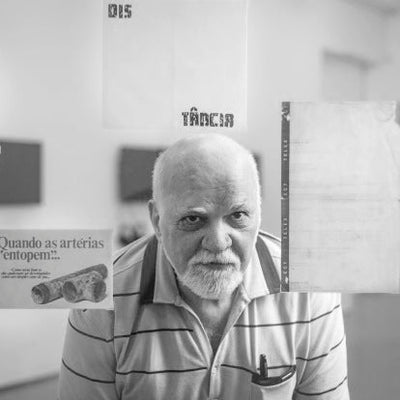A pioneer in the use of contemporary media, such as mail art, audio art, video art and xerography in Brazil, Paulo Bruscky is one of the greatest conceptual artists in Brazilian art.
Beginning his career in the 1960s, Bruscky maintained close contact and corresponded with the Fluxus and Gutai groups, of which he has the largest collection in Latin America. From his first artistic forays, he established himself as a conceptual artist and, during the 1970s, he filled his work with intense political content as a form of protest against the Brazilian dictatorial system. In his works, he also paid homage to artists such as John Cage and Duchamp, and in a 1978 performance, he asked his spectators “What is art, what is it for?”, and reinforced this type of questioning in other works such as “Confirmado: é arte” (Confirmed: it is art) or “Is art reversible?”.
Paulo Bruscky was responsible for renewing the national art scene in the 1970s and for introducing other types of media into Brazilian art, such as photocopies, faxes, stamps, and "artdoor," among others. The artist develops, through the use of words and intertextuality, a work full of meaning. Through mail art, he was able to circumvent censorship during the 1970s within the International Mail Art Movement. The issues of original and copy, very present in contemporary art, also become visible in works such as "Arte com firma registro" (Art with recognized signature). In the 1970s, Bruscky also experimented with body and new technologies, including those from the medical field, such as the set of works "Meu cérebro desenha assim" (My brain draws like this), "Sentimentos: Um poema feito com o coração" (Feelings: A poem made with the heart), and "Autum Radium Retratum" (Autum Radium Portrait), among others. His pioneering work is also part of the photolanguage of the 1970s, through series such as "Alto retrato", "Dados biográficos", "O eu comigo", "AlimentAção" and "MinoPaulo".
He participated in the 16th, 20th, 26th (special room) and 29th editions of the São Paulo Biennial, the 10th Havana Biennial (special room), the 7th Mercosul Biennial (special room), among other biennials, and the Poli/Gráfica Triennial of San Juan in Puerto Rico. His work is included in the collections of the Centre Pompidou (France), Tate Modern (England), Museum of Modern Art – MoMA (United States), MAM – Museum of Modern Art of São Paulo and MAC USP – Museum of Contemporary Art of the University of São Paulo, Museu d'Art Contemporani de Barcelona (Spain), Museum of Modern Art of Amsterdam (Holland), among others. Throughout his career, he has received numerous awards. In 2009, he was pardoned and received the title of Knight of the Order of Cultural Merit, the highest honor of the Brazilian government, and, in 2011, he was honored with the "hors concours" award for art and technology from the Sergio Motta Institute.



























